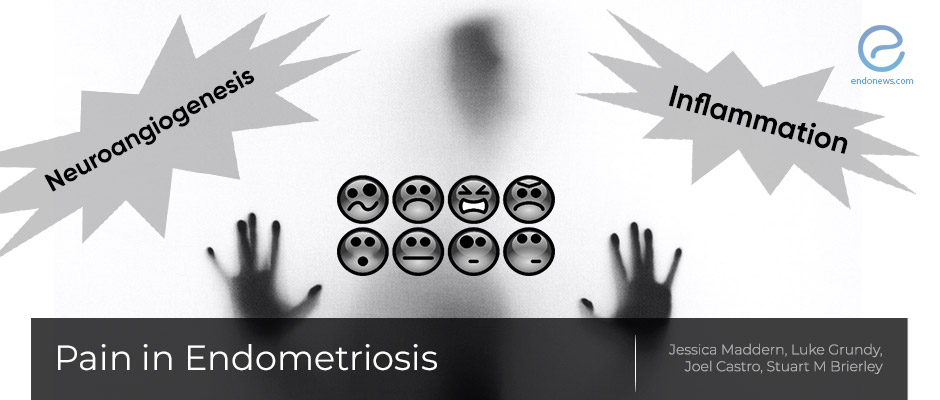Pain in Endometriosis
Nov 18, 2020
The role of inflammation and neuroangiogenesis in endometriosis pain
Key Points
Highlight:
- Dr. Brierley's group highlight advances in mechanisms underlying the development of endometriosis-associated chronic pelvic pain.
Background:
- Endometriosis is a chronic and debilitating condition characterized by chronic pelvic pain and infertility.
- More than 60% of women diagnosed with endometriosis report chronic pelvic pain, however, the mechanisms underlying the pain remain poorly understood.
Key points:
- Although lesion-specific pain is apparent, many reports suggest that additional complex mechanisms are involved in endometriosis-inducing pain.
- Inflammation:
- Menstrual by-products from extrauterine lesions released into the peritoneal cavity initiate immune response.
- Debris from the breakdown of endometriotic lesions and amplified inflammatory milieu lead to an immune reaction evident at lesion sites, contain cytokines, chemokines, growth factors.
- These mediators directly activate sensory nerve endings, suggesting inflammatory mechanisms may be important and endometriosis-associated, and these sensory nerve fibers generate and convey pain to the CNS.
- Neuroangiogenesis
- For endometrial lesions to induce chronic pain, the development of new sensory nerves to convey these signals need to occur.
- Once endometrial fragments adhere to a peritoneal location and become lesions, they undergo a process of neuroangiogenesis.
- Together with the establishment and growth of endometrial lesions, neuroangiogenesis aids irritation and invasion of existing nerves.
Lay Summary
Endometriosis is a chronic and debilitating condition characterized by chronic pelvic pain (CPP) and infertility. It affects approximately 10% of women globally and more than 60% of women diagnosed with endometriosis report CPP. However, the mechanisms underlying the associated pain remain poorly understood.
In this review, Dr.Brierley group from Australia summarizes the most recent clinical and preclinical research to highlight advances in determining the mechanisms underlying the development of endometriosis-associated CPP and chronic abdominal pain. This paper was recently published in the journal of “Frontiers in Cellular Neuroscience”.
In endometriosis-inducing pain, numerous researches mainly focus on the endometrial lesion. Although lesion-specific pain is apparent, many reports suggest that additional complex mechanisms are involved.
1. Inflammation
Menstrual by-products arise from extrauterine lesions and are released into the peritoneal cavity where they initiate immune responses. Not only debris from the breakdown of existing endometriotic lesions, but the amplified inflammatory milieu leads to an immune reaction. This immune response is evident at lesion sites, with increased inflammatory cytokines, chemokines, growth factors, neutrophils, and prostaglandins found within the peritoneal cavity of endometriosis patients.
Crucially, these mediators are all able to directly activate sensory nerve endings, suggesting inflammatory mechanisms may be important in endometriosis-associated. The activation of sensory nerve fibers to generate and convey pain to the CNS is a vital step in the pain processing pathway and contributes to other forms of chronic visceral pain.
2. Neuroangiogenesis
For endometrial lesions to induce chronic pain, the development of new sensory nerves to convey these signals need to occur. A number of studies have now shown that once endometrial fragments adhere to a peritoneal location and become lesions, they undergo a process of neuroangiogenesis. Together with the establishment and growth of endometrial lesions, neuroangiogenesis aids irritation and invasion of existing nerves.
Research Source: https://pubmed.ncbi.nlm.nih.gov/33132854/
Chronic pelvic pain Uterus Inflammation Neuroangiogenesis

